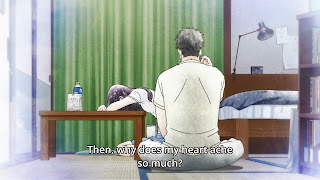During the part where Chiyuki was watching her mother from
outside the house, the glass panel was used as a visual motif separating Chiyuki
and her mother. This could be interpreted as an imagery of the lack of understanding
and the disconnect between mother and daughter. It also can be seen as a symbolic
barrier between the living and the dead.
The interesting thing about this sequence was the restrained
use of the glass panel as a visual motif. In the beginning of this sequence, Chiyuki,
her mother and the glass panel were not shot together. The feeling of separation
between the two was mainly expressed through eyeline matches of Chiyuki watching
her mother from behind the glass panel. The four pairs of images above are shots
of these eyeline matches paired together.
In the first three pairs of shots you might notice a shot
size progression of Chiyuki. These shots progresses from a medium shot,
close-up, and finally to an extreme close-up. This progression served both as a
build up to the drama and the symbolic nature of the glass panel.
 |
 |
In the extreme close-up, Chiyuki was watching her mother walk to her shrine with her favorite food. This
sequence finally led to a shot of Chiyuki, her mother and the glass panel between
them (1st above image). At this moment the glass panel’s symbolism as an emotional barrier and a barrier
between the dead and the living became more apparent. The build up to this
moment made the imagery more tragic. This is relevant because after the
mother expressed her feelings of guilt, Chiyuki deeply regretted her suicide
and wanted to rectify her mistakes. She wanted to break the barrier separating
them by living again, by fixing her wrong doings, and by coming to an understanding
with her mother. The establishment of a symbolic visual motif made her desire for a
second chance feel stronger and consequently made her decision not to do so
feel more difficult.












Comments
Post a Comment